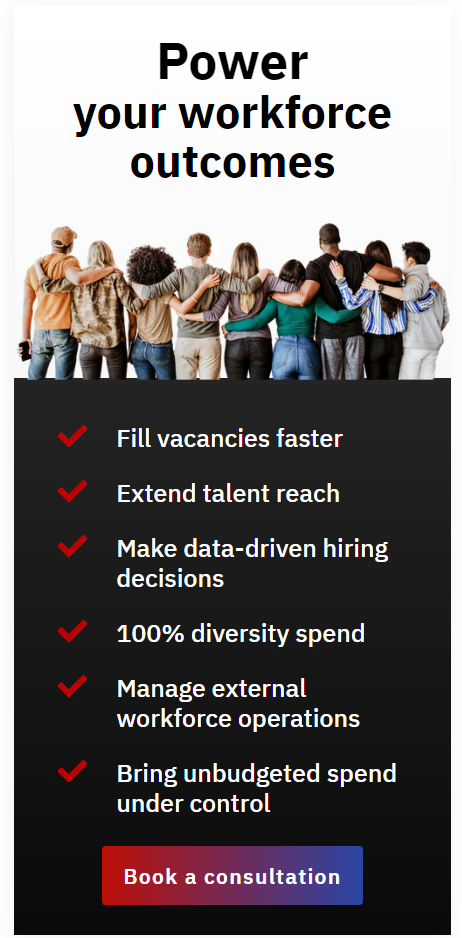Two of the more common acronyms used in the workforce management industry this year have been RPO (Recruitment Process Outsourcing) and MSP ( Managed Service Provider). It looks like 2021 might be the year when one gets subsumed by the other—but why? And what will the impact be on talent strategies? In this article, we investigate.
Moving from Two-Speed Staffing to One
The Contingent Workforce is on the rise. Many U.S. employers today fulfill over half of their talent needs by sourcing contingent workers (independent contractors, freelancers, consultants, etc.)
This is happening against a background of industries changing shape thanks to the pandemic. The writing is on the wall for like any organization unable to flex its workforce up and down to satisfy ever-changing demand requirements without facing a high transitional cost overhead. Agility has become the watchword of business in 2020.
Up to this year, it was common for employees and contingent workers to be sourced through different teams (often different departments), using their own discrete systems, people processes, and data sets. But, when almost one in every two people serving your business isn’t employed, leaders have to re-think their talent strategy. At least, that’s what many of our customers have told us this year.
It’s no longer practical or economic to carry the cost of running two separate sourcing and management approaches for fast-turnaround contingent hiring and slow-burn recruitment and employer management. There has to be a ‘third-way.’ Increasingly, that third-way is being described as ‘Total Talent Management.’
What’s the Difference?
Recruitment Process Outsourcers (RPOs) are companies that outsource the recruitment function for employers. Often, they will bring onboard a dedicated on-premise team to fulfill recruiting activities; hopefully possessing a heady blend of industry and recruitment knowledge, served up with a passion for people, customer service, and for achieving partnering outcomes.
Managed Service Providers (MSPs) on the other hand, are organizations tasked with managing contingent workforce supply chains and fulfilling contingent workforce management administrative tasks such as background checks, supplier reviews, policy compliance, and regulatory management.
Revisiting Talent Partnerships
To support a shift to Total Talent Management—I.e., a strategy that envelopes both employee recruitment and contingent workforce hiring into a single people, process, systems, and data biosphere, also demands a re-think of talent partnering ideas. This means ultimately, businesses only need one partner to manage both sides of their talent ecosystem. The question becomes, therefore, what does that partner look like?
One of the significant advantages MSPs have over their RPO counterparts is a deep knowledge of Vendor Management Systems and the overarching ‘people, process, technology, and data’ ecosystem that modern flexible workforce management programs demand. All the characteristics of an RPO operation have to—by necessity—be fulfilled by an MSP in order to operate in this highly competitive space. For this reason, 2021 promises to be the year when the ‘Talent Partnering Industry’ morphs into something different; with leading MSPs embracing a Total Talent Management approach that subsumes RPO functions as part of a holistic solutions offering.
Diana Doro, Vice President of Sales at Workspend Inc., thinks this shift in capabilities for MSPs is not before time—and it’s going to be essential.
“For too long, talent leaders have been placed in the role of ‘service and technology integrators.’ It’s been the leaders of organizational talent programs who’ve found themselves charged with trying to work out how to dovetail together a collection of partnerships and technologies to create a workable talent ecosystem for their business. RPOs and MSPs have been considered separately, resulting in a confusing talent landscape. Moving forward, it’s going to be the responsibility of MSPs to harness the best methods and tools to discharge Total Talent Management on behalf of organizations, leaning on their knowledge of the talent industry and the application of best-in-class technology. MSPs like Workspend perform this vital ‘knowledge-expert and tech integrator’ role today. I think in 2021, the difference will be that talent leaders are going to be LOOKING for Total Talent Management solutions partners able to blend MSP with RPO in the best possible way to achieve their talent strategy.”
Making Total Talent Management Work
We can expect more companies to turn fanciful ‘what-if’ discussions around Total Talent Management into something more tangible in 2021. Talent Partnerships—in the form of hi-touch people-centric, but technology savvy MSP providers—will be essential to make this change happen.
It’s unreasonable to think that organizations will distract themselves rom their core business activities to become talent management experts. A step change in talent strategies towards a homogenized ‘one-speed’ approach is only likely to be achieved when supplier partners step up to the plate and start to offer configurable but ready-to-serve partnering solutions that fit the Total Talent Management (TTM) model, and brush away the learning pains and technology integration challenges that organizations have faced to-date. The morphing of RPO and MSP into a ‘third-way’ is likely to be the way to go for buyers and MSPs alike.

Ian Tomlin
Author

